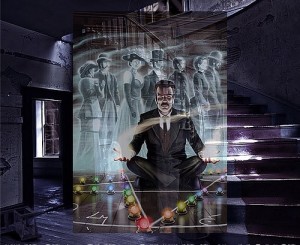Thomas Carnacki, a.k.a. the Ghost-Finder, is the central figure in a collection of supernatural detective short stories by author William Hope Hodgson. The anthology was first published in 1913 by the UK publisher Eveleigh Nash.
Some History, First
In the years preceding World War I (1914-1918), Spiritualism in Europe was on a high. Seances and mediumship were acceptable, in polite society.
During The Great War itself, attempts by families to communicate with loved ones recently departed from the field of battle were not uncommon.
And tales of spirit contacts, ghosts, and hauntings became increasingly popular.
A Man, for Those Times
Carnacki’s first name is revealed as Thomas, in a conversational aside with his mother, from “The Searcher of the End House”.
This early adventure has Thomas and the old lady personally embroiled in a suspected haunting at the house they’ve just rented. Subsequent tales use the character’s surname, throughout.
Having solved the “Searcher” mystery, Carnacki puts himself about as a supernatural investigator – called in by third parties, to deal with supposed threats from The Other Side.
His investigations begin with techniques straight out of the Sherlock Holmes Handbook: a methodical and detailed survey of every inch of the haunted premises.
In particular, Carnacki looks for things like trap doors, mirrors, smoke generators, and suspension wires. Stuff from the bag of tricks used by fake Spiritualist mediums of the time.
The Electric Pentacle
Of course, there’s always the possibility that the supernatural threat is genuine.
Carnacki’s investigative armory therefore includes mystically protective substances like garlic and silver, along with spells and rites like the Ritual of Saaamaaa.
Most intriguing of these is the Electric Pentacle, a device of Carnacki’s own design. It’s basically a mystic pentagram, constructed out of powered glass tubes that give off a trademark eerie blue glow. Magical Protective Circle 2.0.
The Storyteller’s Ritual
Each of Carnacki’s stories begins in the same way.
An invitation to dinner is issued by card to his compatriots, Anderson, Arkright, Jessop, and Taylor.
The group gathers in Carnacki’s digs at Cheyne Walk, Chelsea, for a quality dinner – during which their host says very little, if anything. It’s left for Anderson to narrate this early part of the evening.
Only when the serious business of eating is done, and the gentlemen retire to the lounge for wine and cigars does Carnacki stoke up his tobacco pipe, and break his silence. He then takes up a first-person narrative of his latest case.
Gripping Yarns
The original collection of stories was published by Eveleigh Nash, in 1913.
A later edition by Mycroft & Moran in 1947 included 3 additional tales.
There’s a fair mix.
Some are revealed as elaborate hoaxes, cooked up for mischievous or malevolent reasons, by the living.
Others are genuine encounters with supernatural aggressors. Often, these require Carnacki to spend one or more nights in a haunted room – with just a ring of salt and the Electric Pentacle between him and certain death. The ghosts described in some of these cases are quite horrifically inventive.
Project Gutenberg has a free eBook of Carnacki’s adventures – which are now copyright-free, and available here:
Carnacki, the Ghost-Finder, at Project Gutenberg
Before you download that, here’s a video trailer for the works (available from Ghostwriter Publications), courtesy of YouTube:
Elsewhere…
A new Carnacki story, “Carnacki: Heaven and Hell” by William Meikle was published by Dark Regions Press, in 2011.
Carnacki featured as a character in Alan Moore’s graphic novel series, “The League of Extraordinary Gentlemen”.
That’s the one where various (mostly evil, or ambivalent) literary figures like Dr. Jekyll and Mr. Hyde, The Invisible Man, and Captain Nemo are brought together under the leadership of African adventurer Allan Quartermain, as a sort of “X-Men” of the British Empire.
Carnacki didn’t appear in the abysmal movie that was made from this franchise, in 2003. Which is probably just as well.
“Out, You Go!”
This is Carnacki’s trademark ending to each tale, as he ushers his friends out into the London night.
And it’s our cue, to end this one.
Till next time.
Peace.

